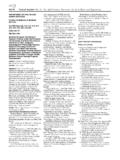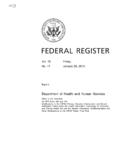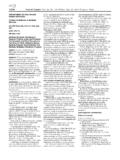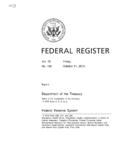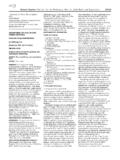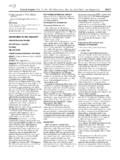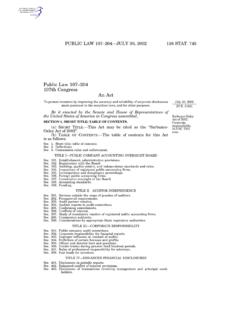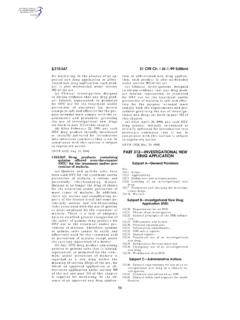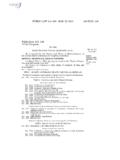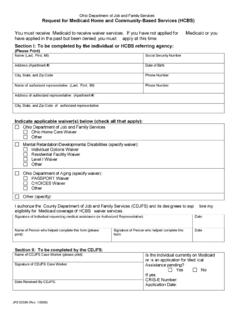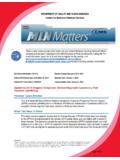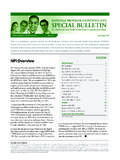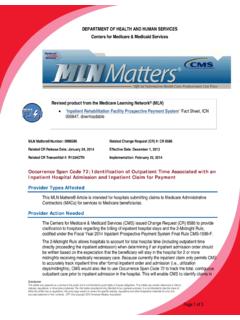Transcription of Department of Health and Human Services - GPO
1 Vol. 81 Friday, No. 180 September 16, 2016 Part II Department of Health and Human Services Centers for Medicare & medicaid Services 42 CFR Parts 403, 416, 418, et al. Medicare and medicaid Programs; Emergency Preparedness Requirements for Medicare and medicaid Participating Providers and Suppliers; Final Rule VerDate Sep<11>2014 19:01 Sep 15, 2016 Jkt 238001 PO 00000 Frm 00001 Fmt 4717 Sfmt 4717 E:\FR\FM\ 16 SER2mstockstill on DSK3G9T082 PROD with RULES263860 Federal Register/ Vol. 81, No. 180 / Friday, September 16, 2016 / Rules and Regulations Department OF Health AND Human Services Centers for Medicare & medicaid Services 42 CFR Parts 403, 416, 418, 441, 460, 482, 483, 484, 485, 486, 491, and 494 [CMS 3178 F] RIN 0938 AO91 Medicare and medicaid Programs; Emergency Preparedness Requirements for Medicare and medicaid Participating Providers and Suppliers AGENCY: Centers for Medicare & medicaid Services (CMS), HHS.
2 ACTION: Final rule. SUMMARY: This final rule establishes national emergency preparedness requirements for Medicare- and medicaid -participating providers and suppliers to plan adequately for both natural and man-made disasters, and coordinate with federal, state, tribal, regional, and local emergency preparedness systems. It will also assist providers and suppliers to adequately prepare to meet the needs of patients, residents, clients, and participants during disasters and emergency situations. Despite some variations, our regulations will provide consistent emergency preparedness requirements, enhance patient safety during emergencies for persons served by Medicare- and medicaid -participating facilities, and establish a more coordinated and defined response to natural and man-made disasters. DATES: Effective date: These regulations are effective on November 15, 2016. Incorporation by reference: The incorporation by reference of certain publications listed in the rule is approved by the Director of the Federal Register November 15, 2016.
3 Implementation date: These regulations must be implemented by November 15, 2017. FOR FURTHER INFORMATION CONTACT: Janice Graham, (410) 786 8020. Mary Collins, (410) 786 3189. Diane Corning, (410) 786 8486. Kianna Banks (410) 786 3498. Ronisha Blackstone, (410) 786 6882. Alpha-Banu Huq, (410) 786 8687. Lisa Parker, (410) 786 4665. SUPPLEMENTARY INFORMATION: Acronyms AAAHC Accreditation Association for Ambulatory Health Care, Inc. AAAASF American Association for Accreditation for Ambulatory Surgery Facilities, Inc. AAR/IP After Action Report/Improvement Plan ACHC Accreditation Commission for Health Care, Inc. ACHE American College of Healthcare Executives AHA American Hospital Association AO Accrediting Organization AOA/HFAP American Osteopathic Association/Healthcare Facilities Accreditation Program ASC Ambulatory Surgical Center ARCAH Accreditation Requirements for Critical Access Hospitals ASPR Assistant Secretary for Preparedness and Response BLS Bureau of Labor Statistics BTCDP Bioterrorism Training and Curriculum Development Program CAH Critical Access Hospital CAMCAH Comprehensive Accreditation Manual for Critical Access Hospitals CAMH Comprehensive Accreditation Manual for Hospitals CASPER Certification and the Survey Provider Enhanced Reporting CDC Centers for Disease Control and Prevention CON Certificate of Need CfCs Conditions for Coverage and Conditions for Certification CHAP Community Health Accreditation Program CMHC Community Mental Health Center
4 CMS Centers for Medicare and medicaid Services COI Collection of Information CoPs Conditions of Participation CORF Comprehensive Outpatient Rehabilitation Facilities CPHP Centers for Public Health Preparedness CRI Cities Readiness Initiative DHS Department of Homeland Security DHHS Department of Health and Human Services DNV GL Det Norske Veritas GL Healthcare DOL Department of Labor DPU Distinct Part Units DSA Donation Service Area EOP Emergency Operations Plans EC Environment of Care EMP Emergency Management Plan EP Emergency Preparedness ESAR VHP Emergency System for Advance Registration of Volunteer Health Professionals ESF Emergency Support Function ESRD End-Stage Renal Disease FEMA Federal Emergency Management Agency FDA Food and Drug Administration FORHP Federal Office of Rural Health Policy FRI Federal Reserve Inventories FQHC Federally Qualified Health Center GAO Government Accountability Office HFAP Healthcare Facilities Accreditation Program HHA Home Health Agencies HPP Hospital Preparedness Program HRSA Health Resources and Services Administration HSC Homeland Security Council HSEEP Homeland Security Exercise and Evaluation Program HSPD Homeland Security Presidential Directive HVA Hazard Vulnerability Analysis or Assessment ICFs/IID Intermediate Care Facilities for Individuals with Intellectual Disabilities ICR Information Collection Requirements IDG Interdisciplinary Group IOM Institute of Medicine JPATS Joint Patient Assessment and Tracking System LEP Limited English Proficiency LD Leadership LPHA Local Public Health Agencies LSC Life Safety Code LTC Long Term Care MMRS Metropolitan Medical Response System MRC Medical Reserve Corps MS Medical Staff NDMS National
5 Disaster Medical System NFs Nursing Facilities NFPA National Fire Protection Association NIMS National Incident Management System NIOSH National Institute for Occupational Safety and Health NLTN National Laboratory Training Network NRP National Response Plan NRF National Response Framework NSS National Security Staff OBRA Omnibus Budget Reconciliation Act OIG Office of the Inspector General OPHPR Office of Public Health Preparedness and Response OPO Organ Procurement Organization OPT Outpatient Physical Therapy OPTN Organ Procurement and Transplantation Network OSHA Occupational Safety and Health Administration PACE Program for the All-Inclusive Care for the Elderly PAHPA Pandemic and All-Hazards Preparedness Act PAHPRA Pandemic and All-Hazards Preparedness Reauthorization Act PCT Patient Care Technician PPE Personal Protection Equipment PHEP Public Health Emergency Preparedness PHS Act Public Health Service Act PIN Policy Information Notice PPD Presidential Policy Directive PRTF Psychiatric Residential Treatment Facilities QAPI Quality Assessment and Performance Improvement QIES Quality Improvement and Evaluation System RFA Regulatory Flexibility Act RNHCIs Religious Nonmedical Health Care Institutions RHC Rural Health Clinic SAMHSA Substance Abuse and Mental Health Services Administration SLP Speech Language Pathology SNF Skilled Nursing Facility SNS Strategic National Stockpile TEFRA Tax Equity and Fiscal Responsibility Act TFAH Trust for America s Health TJC The Joint Commission TRACIE Technical Resources, Assistance Center, and Information Exchange VerDate Sep<11>2014 19:01 Sep 15, 2016 Jkt 238001 PO 00000 Frm 00002 Fmt 4701 Sfmt 4700 E.
6 \FR\FM\ 16 SER2mstockstill on DSK3G9T082 PROD with RULES263861 Federal Register/ Vol. 81, No. 180 / Friday, September 16, 2016 / Rules and Regulations TTX Tabletop Exercise UMRA Unfunded Mandates Reform Act UNOS United Network for Organ Sharing UPMC University of Pittsburgh Medical Center WHO World Health Organization Table of Contents I. Overview A. Executive Summary 1. Purpose 2. Summary of the Major Provisions B. Current State of Emergency Preparedness C. Statutory and Regulatory Background II. Provisions of the Proposed Rule and Responses to Public Comments A. General Comments 1. Integrated Health Systems 2. Requests for Technical Assistance and Funding 3. Requirement To Track Patients and Staff B. Implementation Date C. Emergency Preparedness Regulations for Hospitals ( ) 1. Risk Assessment and Emergency Plan ( (a)) 2. Policies and Procedures ( (b) 3. Communication Plan ( (c) 4.))
7 Training and Testing ( (d) 5. Emergency Fuel and Generator Testing ( (e) D. Emergency Preparedness Regulations for Religious Nonmedical Health Care Institutions (RNHCIs) ( ) E. Emergency Preparedness Regulations for Ambulatory Surgical Centers (ASCs) ( ) F. Emergency Preparedness Regulations for Hospices ( ) G. Emergency Preparedness Regulations for Psychiatric Residential Treatment Facilities (PRTFs) ( ) H. Emergency Preparedness Regulations for Programs of All-Inclusive Care for the Elderly (PACE) ( ) I. Emergency Preparedness Regulations for Transplant Centers ( ) J. Emergency Preparedness Regulations for Long-Term Care (LTC) Facilities ( ) K. Emergency Preparedness Regulations for Intermediate Care Facilities for Individuals With Intellectual Disabilities (ICF/IID) ( ) L. Emergency Preparedness Regulations for Home Health Agencies (HHAs) ( ) M. Emergency Preparedness Regulations for Comprehensive Outpatient Rehabilitation Facilities (CORFs) ( ) N.))
8 Emergency Preparedness Regulations for Critical Access Hospitals (CAHs) ( ) O. Emergency Preparedness Regulations for Clinics, Rehabilitation Agencies, and Public Health Agencies as Providers of Outpatient Physical Therapy and Speech-Language Pathology Services (Organizations) ( ) P. Emergency Preparedness Regulations for Community Mental Health Centers (CMHCs) ( ) Q. Emergency Preparedness Regulations for Organ Procurement Organizations (OPOs) ( ) R. Emergency Preparedness Regulations for Rural Health Clinics (RHCs) and Federally Qualified Health Centers (FQHCs) ( ) S. Emergency Preparedness Regulations for End-Stage Renal Disease (ESRD) Facilities ( ) III. Provisions of the Final Regulations A. Changes Included in the Final Rule B. Incorporation by Reference IV. Collection of Information V. Regulatory Impact Analysis VI. Waiver of Proposed Rulemaking I. Overview A. Executive Summary 1. Purpose We have reviewed existing Medicare emergency regulatory preparedness requirements for both providers and suppliers.
9 We found that many providers and suppliers have emergency preparedness requirements, but those requirements do not go far enough in ensuring that these providers and suppliers are equipped and prepared to help protect those they serve during emergencies and disasters. Hospitals, for example, are currently required to have emergency power and lighting in some specified areas and there must be facilities for emergency gas and water supply. We believe that these existing requirements are generally insufficient in the face of the needs of the patients, staff and communities, and do not address inconsistency in the level of emergency preparedness amongst healthcare providers. For example, while some accreditation organizations have standards that exceed CMS current requirements for hospitals by requiring them to conduct a risk assessment, there are other providers and suppliers who do not have any emergency preparedness requirements, such as Community Mental Health Centers (CMHCs) and Psychiatric Residential Treatment Facilities (PRTFs).
10 We concluded that current emergency preparedness requirements are not comprehensive enough to address the complexities of the actual emergencies. Over the past several years, the United States has been challenged by several natural and man- made disasters. As a result of the September 11, 2001 terrorist attacks, the subsequent anthrax attacks, the catastrophic hurricanes in the Gulf Coast states in 2005, flooding in the Midwestern states in 2008, the 2009 H1N1 influenza pandemic, tornadoes and floods in the spring of 2011, and Hurricane Sandy in 2012, our nation s Health security and readiness for public Health emergencies have been on the national agenda. This final rule issues emergency preparedness requirements that establish a comprehensive, consistent, flexible, and dynamic regulatory approach to emergency preparedness and response that incorporates the lessons learned from the past, combined with the proven best practices of the present.
